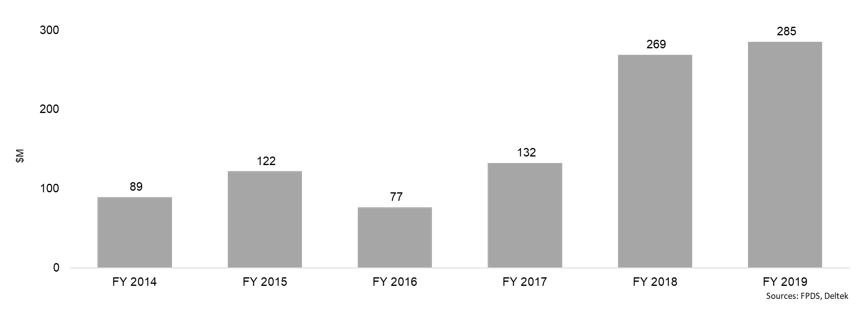The Push to Use Artificial Intelligence Drives the Army to the Cloud
Published: October 21, 2020
Federal Market AnalysisARMYCloud ComputingInformation TechnologyPolicy and LegislationSpending Trends
Army updates its enterprise cloud strategy.
Key Takeaways
- Army’s new Cloud Plan takes a holistic look at cloud adoption by emphasizing the importance of workforce, data management, and emerging technologies to the Service’s efforts.
- The plan will lead to a hybrid cloud environment leveraging best-in-class commercial technologies.
- Army will spend as much as $700M in the next few years realizing its cloud vision.
When it published its cloud strategy back in 2015, the U.S. Army looked poised to lead the Department of Defense into a new computing paradigm. Its spending on cloud had begun accelerating and senior officials from the Secretary on down lauded the idea of leveraging a commercial computing infrastructure that was more secure and more powerful than anything the Army itself could provide. Several years on, the Army’s cloud spending had languished and its focus evaporated. Contract vehicles put into place to accelerate the adoption of cloud capabilities remained largely unused (anyone remember the ACCENT Basic Ordering Agreement?) and industry looked elsewhere for near-term business opportunities.
In 2018, the picture began to change. LTG Bruce Crawford became the Army’s new CIO/G-6 in August 2017 and organizations such as the Program Executive Office Enterprise Information Systems began doing more cloud-related work. The DOD received authority from Congress to use Other Transaction Authority for technology procurement and, suddenly, after all of these developments Army’s spending on cloud more than doubled.
Army took the next step in late FY 2019 by opening a new Enterprise Cloud Management Office (ECMO) to provide direction for its investments in cloud that it formerly lacked. Now that office has produced a strategy document intended to update the 2015 Army Cloud Strategy.
The new Army Cloud Plan came out last week, providing guidance for the Service’s path to the cloud. But while the security and capability benefits of cloud computing are by now well known, those things are only part of what’s finally driving the Army to the cloud with new urgency. The core reason that the Army is embracing the cloud has to do with its desire to use emerging artificial intelligence (AI) capabilities as part of a weaponized information dominance strategy. In other words, although the army recognizes the business benefits of cloud it is adopting the technology because it will be used as a weapons system.
Getting there will not be easy. As the Cloud Plan points out, effort will be required on several fronts for the Army to realize its goals. These include:
- Adjusting Acquisition Practices to embrace service-enabled architecture (a new version of the old SOA construct), agile software development, prototype usage, and the building of cloud-native applications.
- Training the Workforce to address the need for multi-disciplinary teams, experts in digital sciences, analytics specialists, big data mavens, and artificial intelligence engineers, etc.
- Establishing Governance Structures to prepare the Army organizationally for the changes that cloud-based AI will bring. This includes a focus on data management to maximize the value and usefulness of the cloud paradigm for military operations.
- Building a Secure Cloud Infrastructure to provide shared services, enable the warfighting mission, and develop cloud-native capabilities.
- Standardizing Data Management to maximize interoperability and the usefulness for data.
- Protecting Data by adopting a zero-trust approach that facilitates digital overmatch.
Implications for Industry
The Army has already proven it cannot get to its new paradigm without the support of trusted commercial partners. They will be required every step of the way, providing not only engineering expertise, but also training services, SaaS capabilities, and IaaS and PaaS infrastructures for the Army’s vision of a modern hybrid cloud environment. Fulfilling all of these types of requirements will be the job of commercial partners who will benefit from the $700M that the Army anticipates spending on cloud over the next few years.
